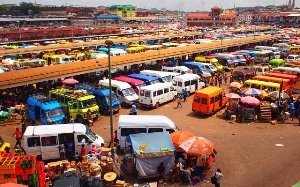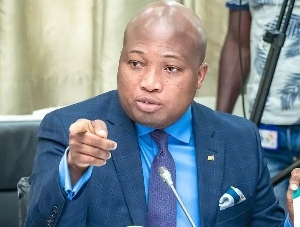 Victor Yaw Asante, Head, CCIB, First National Bank Ghana
Victor Yaw Asante, Head, CCIB, First National Bank Ghana
After a largely successful second year of implementing reforms to correct imbalances in the economy inherited in 2016, Ghana’s current administration aims to grow the economy faster in 2019.
The government has projected gross domestic product to expand 7.6% (using rebased data) in 2019 from a revised projection of 5.6% in 2018, which we think is largely attainable because of four main factors: a bigger though accommodative fiscal deficit target; higher oil output; a more liquid and resilient banking industry after the clean-up and recapitalization; and lastly a stable macroeconomic environment barring any serious hitch to revenue collection.
After changing the way it measures GDP, the Ghana Statistical Service in September said the Ghanaian economy was a quarter bigger than previously estimated, valuing the economy in 2017 based on the new data as 256.7-billion cedis (US$54.6-billion).
After the available new information, the ministry of finance revised the 2018 growth forecast down to 5.6% from 6.8%. While change in the base data was a factor, this year was marked by government expenditure cuts as taxes fell short, a slowdown in loans amid a banking crisis and the attendant reduction in consumer spending.
Ghana is aiming for a budget deficit of 4.2% of the GDP next year from a projected 3.7% of the GDP this year.
Given that this is being subjected to the expanded rebased GDP, it represents a significant proposed jump in government spend from the preceding year. It is worthy to note that as part of the spending plan for 2019, capital expenditure is rising by more than half to 8.5-billion cedis. This would play a major part in invigorating other sectors of the economy, jobs as well as consumption.
At the moment, we see oil production increasing next year as field operator Tullow Oil Plc plans to ramp up output at the country’s two main fields: Jubilee and TEN. While the two fields were producing a combined 170,000 barrels per day as of October 2018, Tullow sees it rising to 180,000 barrels by the end of December this year. We see the average daily output from these fields rising next year as Tullow plans to drill eight (8) new wells.
There are no planned field shutdowns like this year when Jubilee was closed down three times to enable repair works related to the Turret Remediation Project on the Jubilee FPSO.
While field operator of the Sankofa-Gye Nyame field, Eni, has not made any announcement on expanding crude output next year from the current 25,000 barrels per day, next year marks a full year of gas production after starting operations in August 2018. Similarly the completion of the interconnection pipeline for gas import and export between the Jubilee and TEN fields in the first half of this year is expected to support increased gas production next year.
Ghana over the past one and a half years sought to clean up its banking industry, boosting liquidity and engendering stronger corporate governance. The move led to the close down of seven (7) privately-owned lenders found guilty of corporate governance and capital adequacy breaches.
Since the central bank’s directive to lenders in September last year to increase the minimum capital to 400 million cedis from the current 120 million cedis by December 2018, there has been a substantial capital injection by banks ahead of the deadline. The government also injected the required capital to form a new bank which took over the liabilities and selected assets of five (5) of the failed lenders and committed 8-billion cedis worth of bonds to help meet the gap between the liabilities and assets of the seven.
These steps are helping to strengthen the once porous industry ridden with non-performing loans as the central bank disclosed that 20 banks have met the new minimum capital requirement already. The developments also point to a more liquid industry in 2019 – better armed to grow loans in a sustainable manner.
Credit growth, which slowed to an average 2.8% in the first six months of the year, recovered to 7.3% in July-October, according to central bank data. Non-performing loans also dropped to 20.1% at the end of October from 21.6% a year ago, the data showed.
We think that the latest trend will persist and even improve throughout 2019 as banks refocus from raising capital to growing capital. This focus should significantly drive expansion of private companies across all the sectors including agriculture, industry and services.
We are of the view that the macroeconomic framework of the 2019 budget is favourable for business and will largely be attained, unless revenue collection significantly falls short of targets. So far as the fiscal gap target is concerned, the current administration has demonstrated (since taking over in January 2017) that they won’t disappoint come next year.
The worst-case scenario would be for government to lean towards cutting spending, assuming that revenue would disappoint. The Minister of Finance, Ken Ofori-Atta, said the government in 2019 will seek to pass a law that caps the budget deficit at 5% of the GDP, while a fiscal council would be instituted to promote sustainable public finance.
These proposals emphasize our belief that the government intends to stick to the deficit target.
Past experience in Ghana supports that its fiscal stance very much influences the rest of the macroenvironment such as developments in inflation, interest rates and performance of the local currency which are all critical determinants of private sector growth. Before the country’s GDP growth dropped to a 26-year low of 3.7% in 2016, the budget deficit had topped 10% of the GDP for a third year in 2014 and declined to still a high ratio of 6.7% of the GDP in 2015 and reversed drastically to 8.7% of the GDP in 2016.
The inflation rate over those periods were 17% in December 2014, 17.7% in December 2015 and 15.4% in December 2016. The ease came about because government had started implementing reforms under an International Monetary Fund bailout programme, agreed in April 2015 to help correct the economic environment.
The cedi’s weakness against the US dollar reached 10% in 2016 and the central bank’s policy interest rate rose to a record high of 26%. Worth mentioning is that the country in 2016 recovered from a more than three-year power crisis with cuts that lasted as much as 24 hours. Businesses could not just perform and it therefore came as no surprise that the GDP growth fell to the lowest since 1990.
Following the resolve of the current administration (when it took over to bring down the fiscal deficit and keep it low as a matter of policy and legislation), the other macroeconomic indicators fell in line.
These indicators showed that the government’s fiscal performance gives impetus to what becomes of inflation, interest rates and exchange rate in the Ghanaian economy. Government reduced the budget deficit to 5.9% of the GDP in 2017 and further to 3% of rebased GDP (3.7% of the old GDP) in the first nine months of 2018 versus the target of 2.6% of rebased GDP (3.2% of old GDP).
Given these fiscal trends we’ve seen inflation fall to 11.8% at the end of December 2017 and further to 9.5% at the end of October – all within the Central Bank’s end of year target of 6 to 10 %. The Bank of Ghana therefore has reduced its policy interest rate at 17% after its meeting in November this year. The cedi’s depreciation against the dollar has eased, thanks also to the prudent monetary policy making of the Central Bank.
With our expectation that the government will continue to stick to fiscal targets even after the IMF programme comes to an end this year, and our belief that the Central Bank will continue to make monetary policies to steer inflation towards the bank’s target band, we forecast Ghana’s inflation to be in the upper single digit range by the end of December 2019.
Given that at this juncture most investors might have priced-in the highest possible impact from the US Fed’s interest rate increase, we do not foresee significant external pressure on the local currency going forward.
For us the major risk in the outlook remains the ability of government to collect all the 58.9 billion cedis revenue and grant it is targeting for 2019. Total revenue and grants were 9.5% below target in the first nine months this year. Performance can very much improve next year if the government can go all out on its promise to enforce tax compliance.












